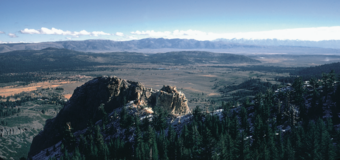
Old Faithful from Observation Point/Kurt Repanshek
Editor's note: Yellowstone Caldera Chronicles is a weekly column written by scientists and collaborators of the Yellowstone Volcano Observatory. This week's contribution is from Michael Poland, geophysicist with the U.S. Geological Survey and Scientist-in-Charge of the Yellowstone Volcano Observatory.
The Yellowstone volcanic system has hosted some very large eruptions. But there have been much larger volcanic explosions in geologic history—including several in the western USA!
Yellowstone is not the only place on Earth where large eruptions have occurred. Caldera-forming eruptions have taken place across the globe from volcanic systems that are similar to Yellowstone.
So how does Yellowstone rank in the geologic history of explosive volcanic eruptions? It may surprise you to know that there have been several eruptions that were much bigger—including in geologically recent times when humans were on the planet!
But first, a definition. The general threshold for defining the largest volcanic eruptions—so-called “super eruptions”—is 1,000 cubic kilometers (km3), or 250 cubic miles (mi3), also defined as “8” on the Volcano Explosivity Index (VEI) scale. This was the size of the eruption that formed Yellowstone caldera, and it is equivalent to 400 million Olympic swimming pools, 400,000 Great Pyramids of Giza, and one-quarter the volume of the Grand Canyon.
And second, a caveat. Assessing the size of a past volcanic eruption is not easy. These calculations use the distribution of volcanic material to determine the volume of the source eruption. Sometimes that material is not well preserved, may have fallen in places that are difficult to access (like the ocean), or may also be buried beneath more recent deposits. In addition, the farther back in time you look, the more likely it is that volcanic material will have been reduced or reshaped by erosion. So there can be a high degree of uncertainty when it comes to deposit volumes, and therefore eruption sizes.
With that out of the way, it is impossible to select one single eruption as definitively the largest in terms of volume. But we can point out three that vie for the title and that were at least five times bigger than the eruption that formed Yellowstone caldera.
The most recent of these massive eruptions occurred from Toba, Indonesia, only 74,000 years ago and had a volume of about 5,300 cubic kilometers (1,272 cubic miles). For many years, this eruption was suspected as causing the near-extinction of humanity, but subsequent research has cast doubt on this hypothesis.
Also in the Western USA, the Wah Wah Springs caldera, in southern Utah, erupted roughly 30 million years ago with a volume of about 5,900 cubic kilometers (1,415 cubic miles). This was the largest of several massive eruptions that occurred in that area at about that time.
The most recent “super eruption” on Earth was from the Taupō volcanic system on the North Island of New Zealand. About 26,500 years ago, an eruption with a volume of approximately 1,200 cubic kilometers (288 cubic miles) occurred there.
As you can see, the formation of Yellowstone caldera 631,000 years ago isn’t the record holder in terms of global eruptions. It’s not even the largest from the Yellowstone hotspot system! But the eruption was still bigger than many, including those that formed other well-known calderas, like Campi Flegrei in Italy about 40,000 years ago (200–300 km3 [48–72 mi3]), Long Valley caldera in California about 760,000 years ago (650 km3 [156 mi3]), and Valles Caldera in New Mexico about 1.1 million years ago (300 km3 [72 mi3]).

![La Garita Mountain (elevation 4179 m [13711 ft]), Colorado](/sites/default/files/resize/remote/899ff91f40ee4417549627cf28f2d058-340x213.jpeg?itok=WNVViuDF)





 Support Essential Coverage of Essential Places
Support Essential Coverage of Essential Places






